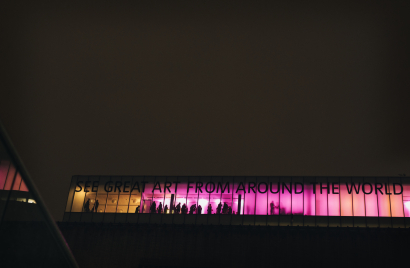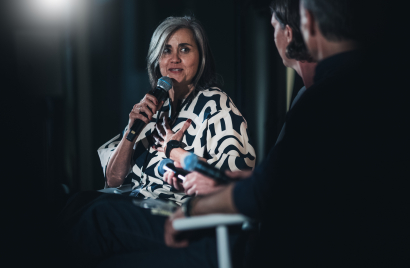
Virgin Media O2 launches summer online safety campaign
Virgin Media O2 and Internet Matters spotlight the importance of having conversations about online safety and starting them early

Jacob Benbunan shares key takeaways from the Into the Bright event

Creating an event that adopts a clearly optimistic approach in the current climate meant a positioning replete with challenges. For as we bid farewell to 2023, whichever direction we look there is a darkness that could easily over-shadow any positivity toward the coming year. From the rise of populist presidents and the environmental burden of consumer brand waste to the existential creative threats of AI and the current very real conflicts destroying essential infrastructure – there are numerous challenges and crises for humanity to face.
But at our recent event, hosted at Tate Modern in London, and deterministically entitled Into the Bright we brought together some of the most interesting creative and marketing leads from across the world to offer insight into how their brands’ approach. Through presentations, questions and nascent conversations, strategies were explored for designing brands to meet people’s needs now and in the future.
What emerged were several key areas of design and branding standing out as most relevant for businesses of many different hues.
As businesses become more complex and multilayered – with their brand showing up across platforms and dimensions – the role of design expands to create an expression system that’s big enough to encompass all areas. Mike Abbink, executive creative director at IBM, referred to a “correct total statement” where a business implements a giant initiative to unify the company and the brand around certain ideas.
This results in a design ethos which encompasses brand values. For IBM this revolved less around selling to, and more about serving, people. This meant designing an expression system that “would work fluidly across any kind of experience” – from the broad brand values to the tiny details, the design system unified it all. Foundational elements of design from typefaces to colour, grids to illustrations were all determined within this system.
The world that designers naturally inhabit – and the language they most often turn to – is of the aesthetic look and feel of things. Their time is spent on pantones or user experiences, kerning or interfaces. But as Abbink shared: “For business leaders and the people who fund the projects I’m trying to create…I do not talk aesthetics, I talk value.”
For CEOs, it is the value of design that is of interest, not necessarily the beauty of it – they want to know how design projects will help the business. And by centring design in business strategy, efficiencies and optimisation, more successful design initiatives are signed off.
From design power to people power – the secret sauce for many businesses. Drawing on her considerable marketing experience, IG Group’s global CMO, Katherine Whitton, made a bold and deliberate statement: “There’s nothing more potent in anyone’s brand armoury that people...It is people who develop, design and deliver every aspect of a brand.”
People are the ultimate brand asset and when they are valued and trusted by the organisation, it reaps the rewards. So, while Whitton witnessed firsthand the damage done when this doesn’t happen – citing prevous bitter, adversarial combat between British Airways’ crew and its then CEO, Wille Walsh – she has also seen how it can work. At Specsavers, she initiated change that brought its people into the picture – raising awareness that its stores are owned by the opticians, bringing the human care side of its story to the fore.
When UNICEF was established after World War II, its premise was to help and support all children – regardless of whether they were on the winning or losing side. It now operates across the world in often extremely difficult situations – more than 400m children are currently affected by conflict. It also means that the UNICEF brand faces more challenges than many. Mila Linares, its chief of brand, talked about how varied the charity’s audiences are – covering everyone from world leaders to 13-year-old girls.
Not only does the brand have to resonate and communicate with these varied people, it must be the “connective tissue” across all its operations and outlets. As a result, the UNICEF brand is more about a philosophy. And unlike most other brands, there are times when it needs to fade into the background. “We live in this tension between wanting to be the most trusted and get the world’s attention and also being shy about brand,” she said. “We’re weaning the organisation away from thinking about brands as big bombastic activations and more about 100 gestures done well over time.”
In this chaotic world, an optimistic approach requires an adaptive mindset. As designers and marketers, we must focus on the value of design and nurturing creative cultures that inspire and support the people around you. In that way, we can all help build innovative and creative processes to make our brands future fit.


Since 2001, Jacob has been the visionary behind Saffron alongside the late Wally Olins. With nearly four decades of experience, Jacob's partnered with the likes of Orange, Repsol, YouTube, Meta, Vueling, A1 Telekom Austria, Engie, and SwissRe. Before Saffron, he was a Principal at Wolff Olins. Jacob champions the global, multicultural, One Saffron approach we’ve embraced from the very beginning. Trained as an engineer at Boston University, you can catch him sharing brand insights in the media or delivering keynote speeches at events like Web Summit and Collision. Jacob is married and has three children.
Looks like you need to create a Creativebrief account to perform this action.
Create account Sign inLooks like you need to create a Creativebrief account to perform this action.
Create account Sign in